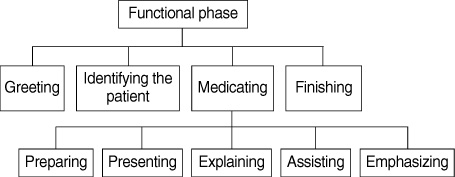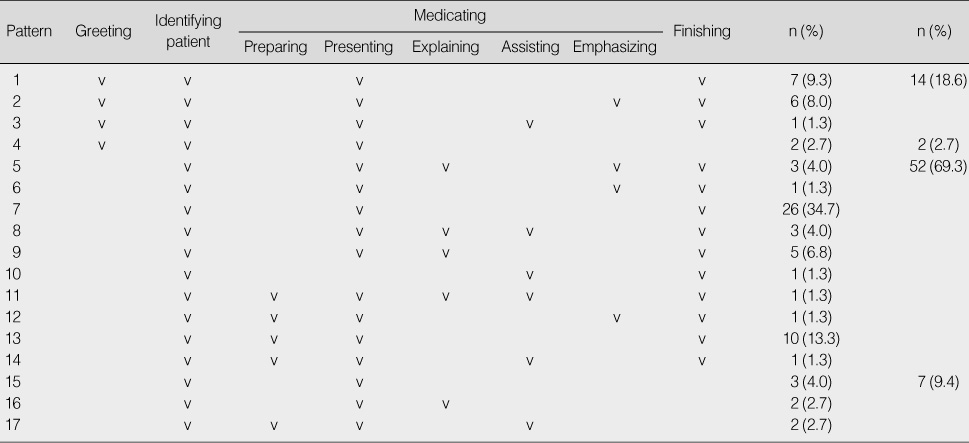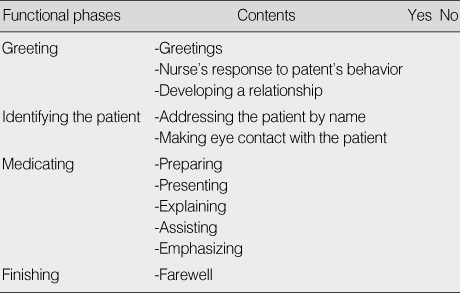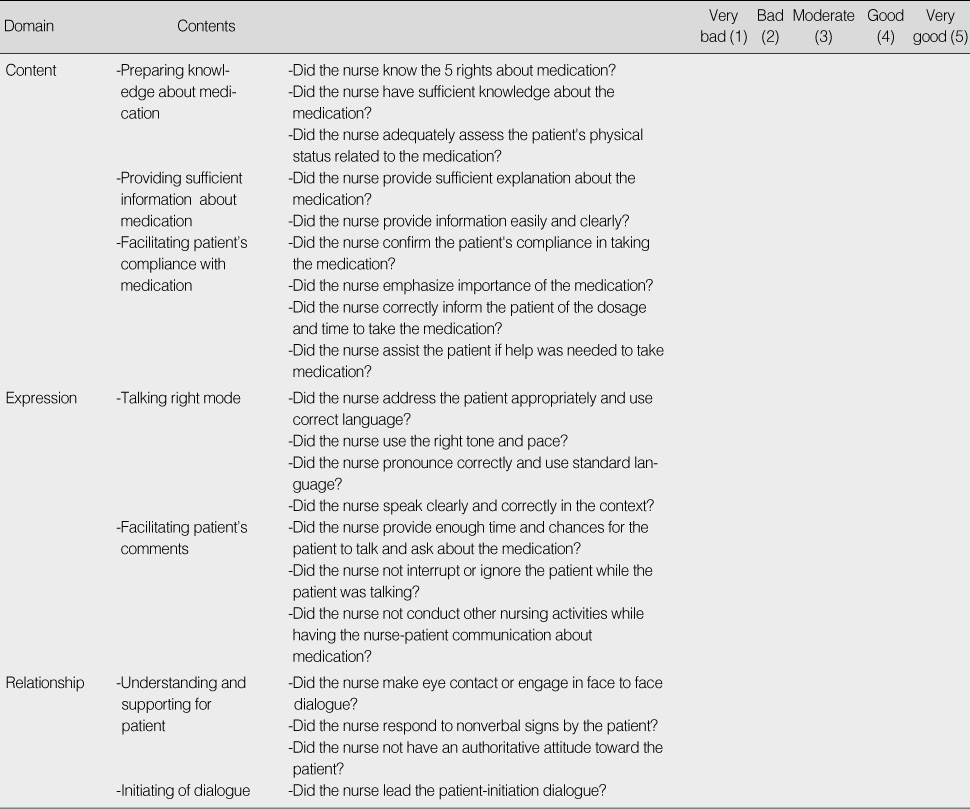Articles
- Page Path
- HOME > J Korean Acad Nurs > Volume 40(1); 2010 > Article
-
Original Article
- Evaluation of Nurses' Competency in Nurse-Patient Communication about Medications: Conversational Analysis Approach
- Haeng-Mi Son
-
Journal of Korean Academy of Nursing 2010;40(1):1-13.
DOI: https://doi.org/10.4040/jkan.2010.40.1.1
Published online: February 28, 2010
Associate Professor, Department of Nursing, University of Ulsan, Ulsan, Korea.
- Address reprint requests to: Son, Haeng-Mi. Department of Nursing, University of Ulsan, 102 Daehak-ro, Nam-gu, Ulsan 680-749, Korea. Tel: 82-52-259-1239, Fax: 82-52-259-1236, sonhm@mail.ulsan.ac.kr
• Received: July 13, 2009 • Accepted: January 10, 2010
Copyright © 2010 Korean Society of Nursing Science
Abstract
-
Purpose
- The purpose of this study was to develop evaluation criteria for conversations about medication and to demonstrate conversational analysis with actual dialogues on medication as examples.
-
Methods
- This study was a secondary analysis of qualitative research using conversational analysis which showed functional phases and patterns of dialogue about medication (greeting, identifying the patient, medicating, finishing). Nurse-patient conversations were videotaped and transcribed and 75 conversations were used for analysis.
-
Results
- Not all functional phases were showed in the conversations about medication. Therefore, conversations about medication can be considered as incomplete dialogues. The evaluation-criteria were represented in terms of the structure and content of the dialogues. Structural evaluation-criteria were the same as the functional phases, as functional stage is the standard for evaluation. The criteria of evaluation for content suggested 3 domains, content, expression, and interaction with 20 items scored on a Likert-type scale of 5-points. Finally, analysis of actual conversations about medication according to the evaluative criteria were provided.
-
Conclusion
- The results provide the basic data to develop educational programs and strategies to improve nurses' competency in conversation about medication.
This study was supported by the Korea Research Foundation Grant funded by the Korean Government (KRF-2005-079-AM0049).
- 1. Bak YI. Introduction into the dialogue analysis. 2001;Seoul, Yeoklak.
- 2. Bak YI. Method and procedures for dialogue analysis. Paper presented at the meeting of the Korean Association for Qualitative Research in Nursing. 2002;02;Seoul.
- 3. Bak YI. Criteria for the evaluation of the braking bad news:An approach of the dialog analysis. German linguistics. 2008;17:109–142.
- 4. Benjamin DM. Reducing medication errors and increasing patient safety: Case studies in clinical pharmacology. Journal of Clinical Pharmacology. 2003;43:768–783.ArticlePubMed
- 5. Bennett J, Harper-Femson LA, Tone J, Rajmohamed Y. Improving medication administration systems: An evaluation study. The Canadian Nurse. 2006;102(8):35–39.
- 6. Burroughs TE, Waterman AD, Gallagher TH, Waterman B, Jeffe DB, Dunagan WC, et al. Patients' concerns about medical errors during hospitalization. Joint Commission Journal on Quality and Patient Safe. 2007;33:5–14.Article
- 7. Caris-Verhallen W, Timmermans L, van Dulmen S. Observation of nurse-patient interaction in oncology: Review of assessment instruments. Patient Education and Counseling. 2004;54:307–320.ArticlePubMed
- 8. Chevalier BA, Parker DS, MacKinnon NJ, Sketris I. Nurses' perceptions of medication safety and medication reconciliation practices. Nursing Leadership. 2006;19(3):61–72.ArticlePubMed
- 9. Deppermann A. Utilization conversation analysis to improve competency in communication for doctor and counselor. Paper presented at the meeting of the Research Institution of Humanities. 2006;02;Seoul, Seoul National University.
- 10. Eisenhauer LA, Hurley AC, Dolan N. Nurses' reported thinking during medication administration. Journal of Nursing Scholarship. 2007;39:82–87.ArticlePubMed
- 11. Hwang EM. A study of contributing factors for performing effective nursing conversation. Docakyoyuk. 2007;39:139–162.
- 12. Jones A. Nurses talking to patients: Exploring conversation analysis as a means of researching nurse-patients communication. International Journal of Nursing Studies. 2003;40:609–618.ArticlePubMed
- 13. Kettunen T, Poskiparta M, Gerlander M. Nurse-patient power relationship: Preliminary evidence of patients' power messages. Patient Education and Counseling. 2002;47:101–113.ArticlePubMed
- 14. Ko MH, Kim CM, Moon JH, Yi MS. Conversation analysis: The study of talk-in-interaction. 2005;Seoul, Goonja Publishing Inc.
- 15. Koczmara C, Jelincic V, Perri D. Communication of medication orders by telephone- "Writing it right". Dynamics. 2006;17:20–24.PubMed
- 16. Lee DW. A conversational analysis of 'doctor-patient' communication: In searching of the interpersonal communication problems and solutions. Hankookeornronjungbo. 2000;45:232–344.
- 17. Lee HJ. A conversational analysis about patient's discomfort between a patient with cancer and a nurse. Journal of Korean Academy of Nursing. 2007;37:145–155.ArticlePubMedPDF
- 18. Lee KJ. Communication and nursing. 1999;Seoul, Shinkwang publishing Inc..
- 19. Manias E, Aitken R, Dunning T. How graduate nurses use protocols to manage patients' medications. Journal of Clinical Nursing. 2005;14:935–944.ArticlePubMed
- 20. Sandelowski M. The problem of rigor in qualitative research. Advances in Nursing Science. 1986;8(3):27–37.ArticlePubMed
- 21. Son HM. Functional phases and patterns of dialogue sequence in nurse-patient conversation about medication. Journal of Korean Academy of Nursing. 2007;37:52–63.ArticlePubMedPDF
- 22. Yi M. Secondary analysis of qualitative data: Methodological issues and implications. Korean Journal of Nursing Query. 2003;12:82–96.
- 23. Yi M. Conversation analysis for improving nursing communication. Journal of Korean Academy of Nursing. 2007;37:772–780.ArticlePubMedPDF
- 24. Yi M, Yih BS. A conversation analysis of communication between patients with dementia and their professional nurses. Journal of Korean Academy of Nursing. 2006;36:1253–1264.ArticlePubMedPDF
- 25. Yi MS. Secondary analysis: Focusing on qualitative research. Journal of Korean Academy of Nursing. 2004;34:35–44.ArticlePubMedPDF
REFERENCES
Figure & Data
REFERENCES
Citations
Citations to this article as recorded by 

- An investigation into health professionals’ perception of the appropriateness of elderspeak in a Korean hospital setting
Miseon Lee, Jeong Youn Lee
Journal of Pragmatics.2021; 172: 181. CrossRef
Evaluation of Nurses' Competency in Nurse-Patient Communication about Medications: Conversational Analysis Approach

Figure 1
Functional phases of dialogue about medication (Son, 2007).
Figure 1
Evaluation of Nurses' Competency in Nurse-Patient Communication about Medications: Conversational Analysis Approach
Frequencies of Functional Phases in Dialogue about Medication (N=75)
Evaluation-criteria for the Structure of Dialogue about Medication
Evaluation-criteria for the Content of Dialogue about Medication
Table 1
Frequencies of Functional Phases in Dialogue about Medication (N=75)
Table 2
Evaluation-criteria for the Structure of Dialogue about Medication
Table 3
Evaluation-criteria for the Content of Dialogue about Medication
 KSNS
KSNS
 E-SUBMISSION
E-SUBMISSION




 Cite
Cite

